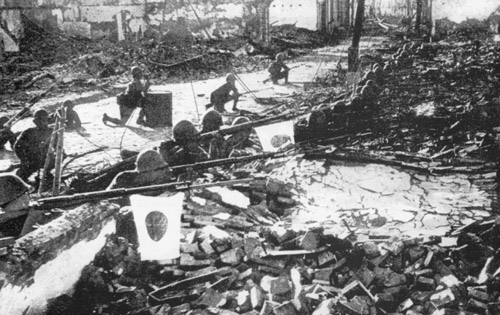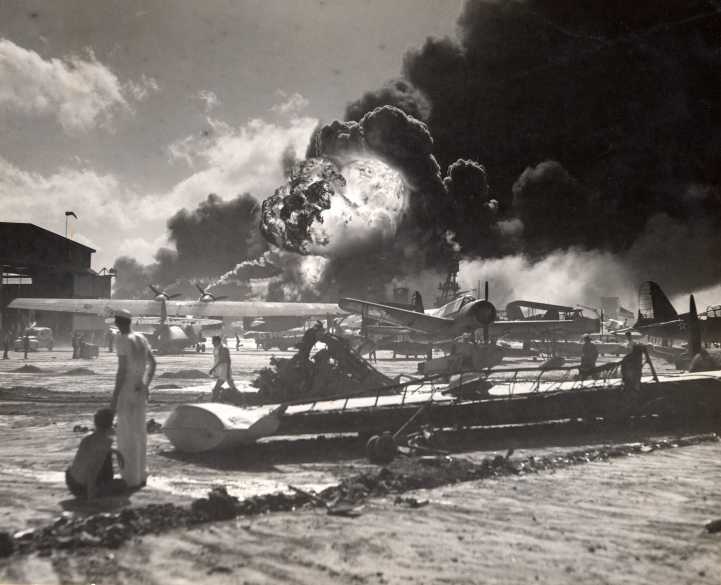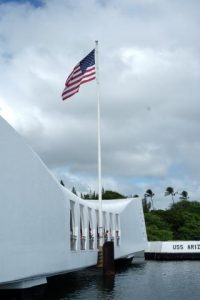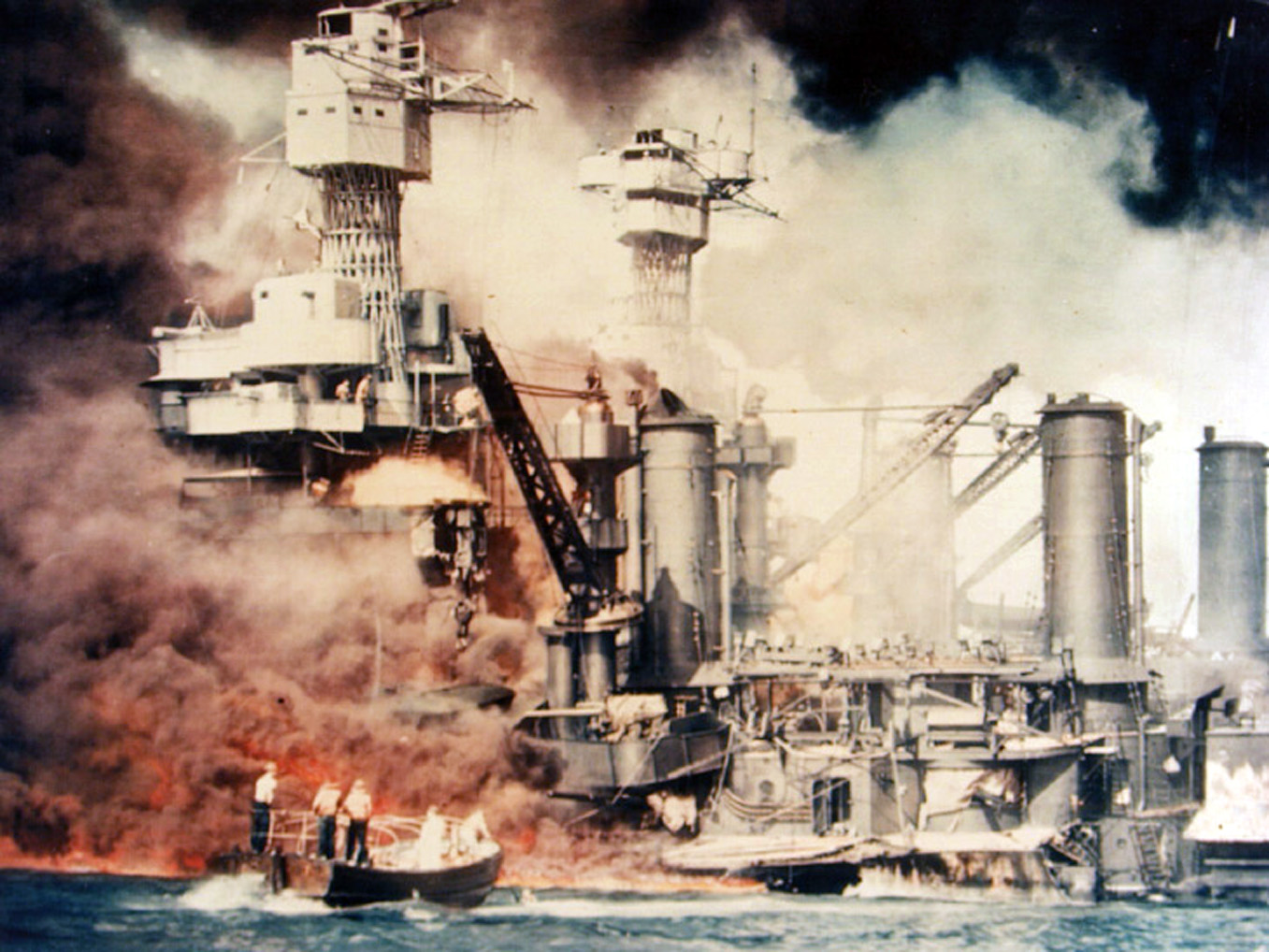The Japanese attack on Pearl Harbor in the Hawaiian Islands on December 7, 1941 marked the official entrance of the United States into World War II.
Background
During the 1930s, Japan, having already annexed Korea in 1910, sought to further expand its empire, particularly to gain natural resources. In 1931, the Japanese invaded Manchuria, a small, resource-rich province in northern China, and set up a puppet state called Manchukuo. In 1937, Japan invaded the rest of China and by some estimates killed as many as 300,000 people during the infamous Nanking Massacre. China would lose as many as 14 million people by the end of World War II.
Western powers were distressed by Japanese expansion, particularly because it violated the “Open Door” Policy supported by the League of Nations (a precursor to the United Nations), which had been put in place to ensure equal trading opportunities with China. The League of Nations reprimanded Japan, but this did nothing to stop its expansion.

As Japan had limited natural resources, 55.4% of its imports at the time came from the United States (Rhodes 39). Beginning in 1937, the U.S. began to embargo supplies of oil, steel, and scrap iron. In December of the same year, Japanese planes sunk the Panay, an American gunboat, in the Yangtze River, killing three Americans. Although Japan said it was a mistake and paid reparations, it further stirred sympathies for China and anger against Japan in the United States.
In 1940, Japan became part of the Axis Alliance with Germany and Italy and occupied parts of French Indochina (modern Vietnam) with the permission of the Vichy government, the puppet state created after the fall of France. In response, the United States put a complete embargo on all trade with Japan. President Roosevelt also moved the majority of the U.S. Pacific Fleet from the West Coast to Pearl Harbor.
The embargo created a dilemma for Japan. The Japanese were reliant on American resources to fuel their war effort, and ultimately concluded that they needed to conquer the resource-rich territories in Southeast Asia to continue. In July 1941, Japan moved into southern Indochina, on the doorstep of colonies controlled by Western powers such as India, Singapore, the Dutch East Indies, and the American-controlled Philippines. Japan knew that this move risked war with the United States.
Surprise Attack
The attack at Pearl Harbor was the idea of Admiral Isoroku Yamamoto, the Commander in Chief of the Japanese Combined Fleet, who argued that it would “give a fatal blow to the enemy fleet” (Rhodes 392). In October 1941, the attack was approved by the Japanese naval general staff. Commanded by Vice Admiral Chuichi Nagumo, the Japanese fleet included six aircraft carriers, 24 supporting ships, and a group of submarines.
The United States was expecting an attack. Ongoing negotiations to end Japanese expansion were not producing results, particularly since the start of the American trade embargo. Only hours before the bombing of Pearl Harbor, Admiral Husband Kimmel, the Commander of the U.S. Pacific Fleet, received a message from the Navy: “This dispatch is to be considered a war warning. Negotiations with Japan looking toward stabilization of conditions in the Pacific have ceased and an aggressive move by Japan is expected within the next few days. Execute an appropriate defensive deployment preparatory to carrying out the tasks assigned” (390). The message did not, however, mention Pearl Harbor as a potential attack site, as the United States was instead expecting an attack on the Philippines.

The first sign of the Japanese fleet racing towards Pearl Harbor came at 7:00 AM the morning of December 7, when two U.S. Army privates on the Hawaiian island of Oahu were just about to turn off a mobile radar station they had manned since 4:00 AM. A slight disturbance on the screen gave pause to their actions – a large yet indistinct patch of light, which appeared to the men to come from 50 planes, seemed to be heading towards the island. Confused, one of the privates called the information center across the island, reaching an army lieutenant who assured them the light was simply a fleet of American B-17s. The lieutenant had heard Hawaiian music playing on the radio station earlier that morning, a signal that typically indicated an approaching American aircraft to Hawaii, and determined that the blotch on the radar’s oscilloscope screen must be the incoming fleet.
Careful Japanese precautions and comprehensive planning allowed the attack on Pearl Harbor to remain completely shielded from US intelligence. For nearly two weeks prior to the attack, Japanese battleships and destroyers had escorted 43 fighters, 51 dive-bombers, 49 high-level bombers, and 40 torpedo planes from six carriers that floated 200 miles north of Pearl Harbor. The aircraft had traveled in complete radio silence in order to catch the Americans by surprise.
At 7:58 AM, the Ford Island command center finally sent a radio alert: “AIR RAID PEARL HARBOR. THIS IS NOT DRILL.” Upon reaching Pearl Harbor, the Japanese torpedo bombers skillfully maneuvered themselves into the harbor in groups of twos and threes in a sudden and forceful attack lasting only minutes. In another hour, a second fleet of 167 additional Japanese aircraft bombarded the site.
American residents who watched the attack from afar observed in horror as the screams of men on the sunken battleships ripped through the air, smoke rose from the sea, and the injured and dead swam in bloody waters slick with burning oil. When the effects of the attack subsided, the grim casualties became known: 2,403 American civilians and military personnel had been killed, and 1,178 wounded. Two battleships and 188 aircraft were destroyed.
Aftermath
The attack caught American military personnel by surprise and was certainly costly, but it did not cripple the U.S. Navy as the Japanese had anticipated. By a stroke of luck, the three American aircraft carriers stationed at Pearl Harbor were not there on the morning of December 7th. The USS Lexington, the USS Enterprise, and the USS Saratoga had been sent on missions during the days before. Aircraft carriers are larger and more difficult to build than other ships, and their survival would prove vital during the Pacific War.

On December 8th, President Roosevelt gave a speech in which he famously called the attack on Pearl Harbor “a date which will live in infamy,” while Congress quickly passed a declaration of war on Japan. Three days later, Germany and Italy declared war on the United States. The War Department completely reorganized itself, as key positions shifted to various trusted officers in order to prepare for the new conflict.
Prior to Pearl Harbor, the United States had sent large amounts of financial aid and military equipment to the Allied cause. The Japanese attack launched the U.S. into a complete struggle against Axis powers and brought American soldiers into the war for the first time. It also united the country, as a Gallup poll conducted during the days after Pearl Harbor showed that 97% of Americans approved of the declaration of war.
Thousands of young men rushed to serve in the Army, Navy, Marine Corps, and Coast Guard. A New York Times article from December 9th reported that the armed forces were “receiving applicants in numbers unprecedented in the history of the nation” and that “many of the men had been in line [at recruiting stations] the whole night.” The Times added the next day that the Army had received 2,684 applications in the two days since declaring war on Japan.
Pearl Harbor also had a marked effect on the Manhattan Project. The S-1 Committee, which ran atomic research prior to the creation of the Manhattan Project, formally held its first meeting on December 18, 1941. This meeting initiated an official shift from the research to the development phase of the project. As S-1 official James Conant noted, “The atmosphere was charged with excitement – the country had been at war nine days, an expansion of the S-1 program was now an accomplished matter. Enthusiasm and optimism reigned” (Rhodes 398).
Legacy
 Japan quickly expanded its Pacific empire, attacking American and British territorial holdings in the Philippines, Guam, Midway Island, Wake Island, Malaya, and Hong Kong. Their tactics were brutal and many more Americans lost their lives. The attack at Pearl Harbor as well as the Bataan Death March have often been cited as justification for the atomic bombings of Hiroshima and Nagasaki. President Truman’s statement notifying the American public of the bombing on Hiroshima on August 6, 1945, included the following words: “The Japanese began the war from the air at Pearl Harbor. They have been repaid many fold.”
Japan quickly expanded its Pacific empire, attacking American and British territorial holdings in the Philippines, Guam, Midway Island, Wake Island, Malaya, and Hong Kong. Their tactics were brutal and many more Americans lost their lives. The attack at Pearl Harbor as well as the Bataan Death March have often been cited as justification for the atomic bombings of Hiroshima and Nagasaki. President Truman’s statement notifying the American public of the bombing on Hiroshima on August 6, 1945, included the following words: “The Japanese began the war from the air at Pearl Harbor. They have been repaid many fold.”
Today, a memorial exists at Pearl Harbor to honor those who lost their lives that day. It includes the USS Arizona Memorial, the USS Oklahoma Memorial, the USS Utah Memorial, parts of Ford Island, and Battleship Row. Built over the battleship whose name it carries, The USS Arizona Memorial receives over 1.8 million visitors each year. You can read AHF’s Alexandra Levy’s account of her visit to the memorials here.
In December 2016, Shinzo Abe became the first sitting Japanese Prime Minister to visit Pearl Harbor. Abe asserted, “We must never repeat the horrors of war again. This is the solemn vow we, the people of Japan, have taken.” He also spoke of “the spirit of tolerance and the power of reconciliation” and offered his “sincere and everlasting condolences to the souls of those who lost their lives.”





